.
Cathédrale Sainte-Croix, Orléans: photo by Kamel15, August 2008
August 12, 1927. I shall confine myself to notes. The familiar torment of loneliness that afflicts me particularly when traveling has for the first time assumed the features of growing old. L. has not come with me. The likelihood that this is because of a misunderstanding is no greater than 10 percent. The likelihood that I have been deceived in the ordinary way is about 90 percent. Admittedly, I myself have created this possibility. This now turns out to be a mistake. If she had come, that would have been the basis for enjoying this trip.
I can be certain that I shall now, alone, find all the places that would have been sheer delight with her. Here I am, for example, sitting in a very quiet and very good restaurant, the Hôtel St. Cathérine in Orléans. The table is precisely the right width for sitting opposite someone. The electric lights are so faint I can barely see to write.
Until midday I was uncertain whether I should travel on my own. If Scholem hadn't been arriving, I probably would not have done so. I simply did not think I could bear his sometimes ostentatious self-assurance.
This afternoon I saw Orléans Cathedral: modern colored-glass windows that mean nothing. Yet above, in the choir, plain glass. The rose window above the entrance, too, is plain: a polar sun. Behind the plain glass of the aisle windows the buttresses can be seen in the half-light, like a shoreline in banks of mist. In the transept the rose windows are in the harsh, barbaric yellows and reds. --- The exterior is incredibly beautiful. Outside, the chancel has a stone foundation from which the shafts and pilasters rise up. It is as if they are rooted in the stone walls.

Cathédrale Sainte-Croix, Orléans: photo by Narisa, 26 April 2011
While I was walking through the cathedral, the organist was practicing.
Everything, especially every trivial thing on this journey, makes me want to burst into tears. For example, the fact that on this trip I do not speak French. (At all!) I weep when I think about the rue de Reuilly, a magic name for me, one that I can no longer use.
Cathédrale Sainte-Croix, Orléans: photo by Kamel15, August 2008
August 13. I slept better than I had expected. From the hotel I went back to the cathedral again. This time I approached it from the Hotel de Ville, which is faced by some older houses rising up on a beautiful slope.



Hôtel Groslot, siège de l'Hôtel de ville d'Orléans, et statue de Jeanne d'Arc, Loiret, Centre, France: photo by Tieum, 28 October 2004
In the cathedral I heard the story of the red hat that hangs from the ceiling.
In the cathedral I heard the story of the red hat that hangs from the ceiling.

Maison de Jeanne d'Arc, Orléans: photo by Vermessen, 25 August 2008
It belonged to a cardinal (probably Cardinal Touchet, who is seated at the feet of the statue of Joan of Arc), and will hang there until it falls of its own accord.
It belonged to a cardinal (probably Cardinal Touchet, who is seated at the feet of the statue of Joan of Arc), and will hang there until it falls of its own accord.

-- From a distance, from the boulevard St. Vincent, the buttresses look like fragments of Christ's crown of thorns. Never have I seen such a thorny cathedral as this one, with its icy cold rose window.
Street, Orléans: photo by Kamel15, August 2008
While I was walking through the town and visiting all the churches listed in the guidebook, it occurred to me that it is quite possible L. really had gone away; in other words, that she may well have gone on a trip with him. Considered perhaps calling at her apartment again shortly before leaving for Berlin, or at the hotel in the rue de la la Chapelle, and observing her if possible.

View from the north bank of the River Loire, Blois: photo by Stevage, 8 May 2006
In Blois. Here you have to sit on the terrace behind the Cathédrale St. Louis if you want to see the famous French clarté, the French limpidité, total harmony of landscape, architecture and the art of gardening.
Cathédrale Saint-Louis, Blois, East End: photo by TTaylor, 2005
Thank God the sky is heavily overcast; the sun has disappeared. I still feel bitterness within me, churned up emotions that refuse to settle down. It was an infallible instinct that bid me make precisely this journey with L., a Parisian. The absent one retreats from me for a second time -- like a landscape, at every moment drawing further away. I place landscapes, courtyards, around her as frames, all of which remain empty. And the whole situation is made worse by my vanity's whispered insistence that all this happened by accident, not design. Even so, when I return to Paris, I will not let my efforts to find her again go too far. In Paris I can survive without her, and indeed cannot really make use of her, as matters stand. It was during the guided tour through the castle of Blois that I suffered most.
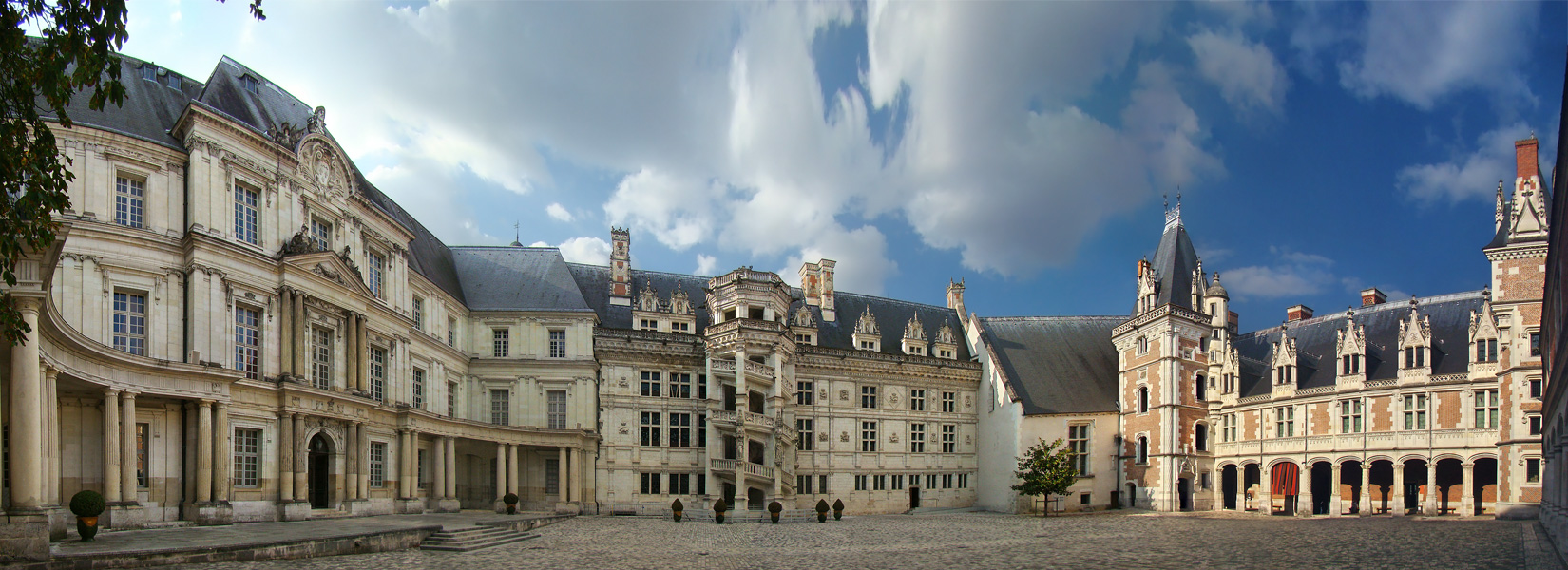
Château de Blois, Loir-et-Cher, Centre, France. Panorama of the interior façades. From right to left: the Louis XII flamboyant wing, the medieval Gothic castle, the François I Renaissance wing, and the Gaston d'Orléans classic wing: photo by Tango7174, 24 September 2008
This was where her astonishment would have made everything bearable, if not agreeable.
As it was, as I gazed around the empty rooms whose walls are painted in imitation of the Gobelins tapestries or Cordoba leather that used to hang there, I could see that I was almost the only person who was alone.
Salle des Etats Généraux, Château de Blois: photo by Manfred Heyde, 10 May 2009
As it was, as I gazed around the empty rooms whose walls are painted in imitation of the Gobelins tapestries or Cordoba leather that used to hang there, I could see that I was almost the only person who was alone.

Chambre du Roi ([king's bedchamber], Château de Blois, with Henry IV's initial H in the floor tiles: photo by MFSG, 13 June 2007
I am not far from tears.

"Chambre de secrets" in the Château de Blois, rumoured (probably apocryphally) to have been used as a hiding place for poisons by Marie de Medici, widow of Henry IV: photo by Stevage, 2 May 2006
What was the point of it all -- not just of all these preparations, but of having made this huge change in my life -- if I cannot contrive to carry out the simplest little planned journey that any traveling salesman could manage? Am I never again to travel anywhere with a woman I desire?

Slate roofs, Tours: photo by Erin Silversmith, June 2005
August 15 [Tours]. To my surprise, I see that comfort is having an effect on my gloomy mood. Since I...
The same day, evening. In short, I have an excellent, luxurious room that will have to make up for L.'s absence as far as possible. I shall presumably not see her again, and I shall make only modest attempts to do so. But I have caught myself trying to conjure up her face, specifically to recall that expression (that coldness, that refusal to make contact with me) which is no doubt the source of my present situation. I made this effort this afternoon beneath the trees in front of the Cafe Universel, behind the big statue of Balzac which shows the master in his dressing gown.
Cathédrale de Saint-Gatien, Tours: photo by Parsifall, 2009
Only the sight of the buildings gives me the feeling of having arrived here in Tours, or wherever it may be, and nowhere else. I stood behind the chancel of St. Gatien. My gaze turned to the dead, gray, nondescript exterior view of the famous stained-glass windows. A moment before, I had been sitting on a bench, looking at the façade; now I was looking at the back of the church, leaning against a wall. It gave me a shock. Compared to this peace, this immediate sense of presence that comes from gazing at great works of architecture, all our ordinary activity is like traveling on a train that suddenly stops with a jerk. Here we are; nothing will take us any further.

Cathédrale de Saint-Gatien, Tours : photo by Parsifall, 2009
Cathédrale de Saint-Gatien, Tours : photo by Parsifall, 2009
Tours has the most cheerful, most childlike rose windows I have ever seen, especially the one over the main portal.
Old houses in the Place Plumereau, Tours: photo by Parsifall, 2009
After that I took a walk behind the cathedral through little streets with low squat buildings. But with what names! Rue Racine, rue Montaigne. And this square is the place St. Gregoire de Tours. A woman was delivering newspapers, and she blew a horn -- a last vestige of the medieval town crier, probably. The houses have two stories, but much lower still are the courtyard walls with the doors in them.
In the cathedral I suddenly cheered up, It occurred to me that a month previously I had been in Chartres -- it was not yet a month since I had met L. -- and she had been marvelously planted (this Parisian rose) between those two cathedrals. And that was as it should be. She had her place.
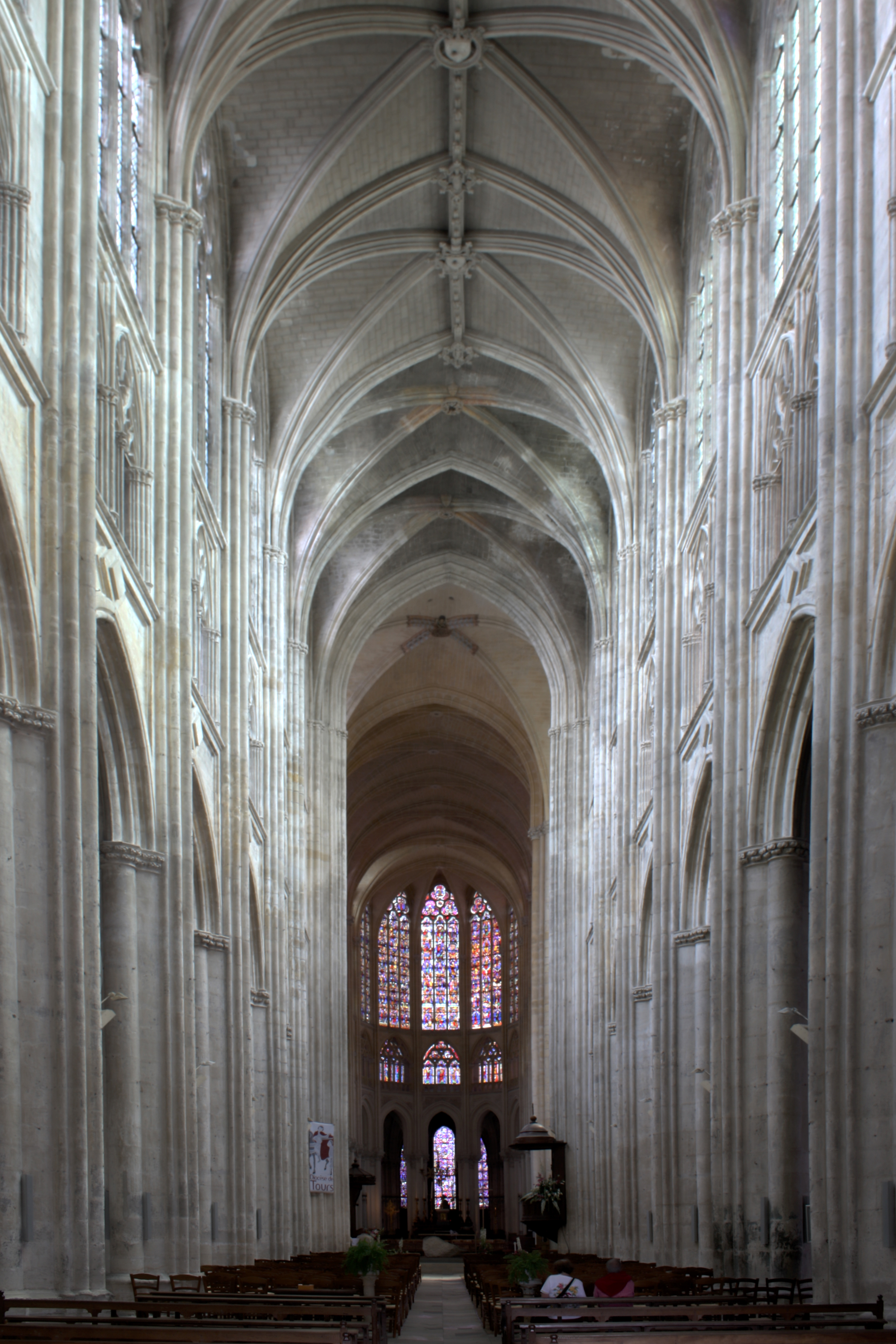
Nave of the Cathédrale de Saint-Gatien, Tours: photo by Guillaume Piolle, 4 July 2009
August 16. I went back to St. Gatien. The stained glass must have had this appearance of faded velvet cloth right from the start.
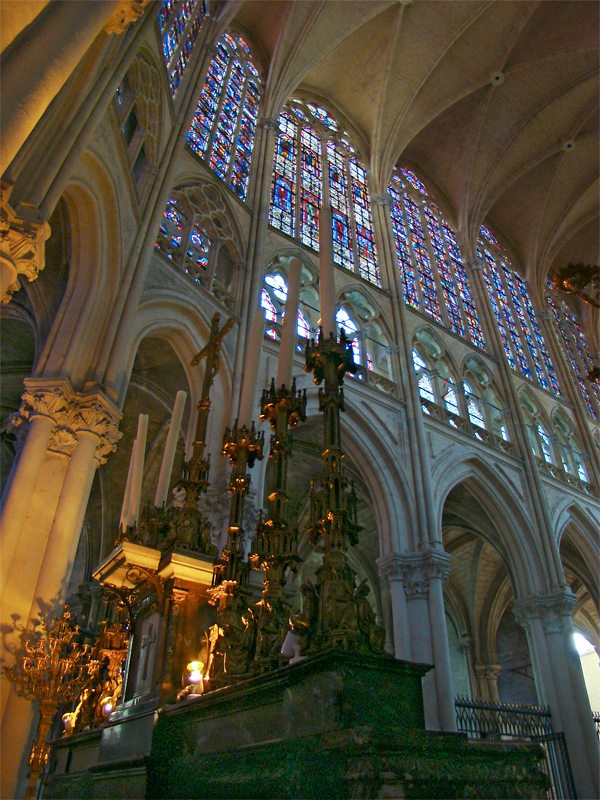
In the cathedral I suddenly cheered up, It occurred to me that a month previously I had been in Chartres -- it was not yet a month since I had met L. -- and she had been marvelously planted (this Parisian rose) between those two cathedrals. And that was as it should be. She had her place.

Nave of the Cathédrale de Saint-Gatien, Tours: photo by Guillaume Piolle, 4 July 2009
August 16. I went back to St. Gatien. The stained glass must have had this appearance of faded velvet cloth right from the start.

Main altar and choir, Cathédrale de Saint-Gatien, Tours: photo by Tango 7174, 22 September 2008
Incidentally, this rose window is an unsurpassable symbol of the Church's way of thinking: from the outside, all slaty, scaly, almost leprous; from the inside, blossoming, intoxicating and golden.


Northern rose window and main organ of the Cathédrale de Saint-Gatien, Tours: photo by Guillaume Piolle, 6 July 2009
When you walk over to the other side of the Loire, St. Gatien does not stand out, as it should, in Gothic splendor above many gables, but rises above the leaves of the trees on the Loire islands and the riverbank promenade. -- Yesterday I saw two chimney stacks on a roof high above the town: a new paradise that Virgil shows with a dramatic gesture to a Dante who recoils with a shiver. -- From the front the cathedral looks out onto the place Quatorze Juillet, and from behind on to the place St. Grégoire de Tours. It looks as if its is resting its head on a cushion and has its feet in the water. Concerning street names: on the sign for the rue August Comte, together with his dates, appears the word Positiviste. What must the good townsfolk think that means? -- (Behind the cathedral: rue du Petit Cupidon.)
I would have had a photograph of L. made on this trip. Apart from that, I find I have to restore my equanimity by imagining that her failure to come was the result of the influence of someone else. For my vanity, and the probabilities of the situation, do not allow me to consider the possibility that she deceived me from start to finish. And to contemplate the thought that we may have missed each other as a result of a misunderstanding would drive me mad.
I would have had a photograph of L. made on this trip. Apart from that, I find I have to restore my equanimity by imagining that her failure to come was the result of the influence of someone else. For my vanity, and the probabilities of the situation, do not allow me to consider the possibility that she deceived me from start to finish. And to contemplate the thought that we may have missed each other as a result of a misunderstanding would drive me mad.
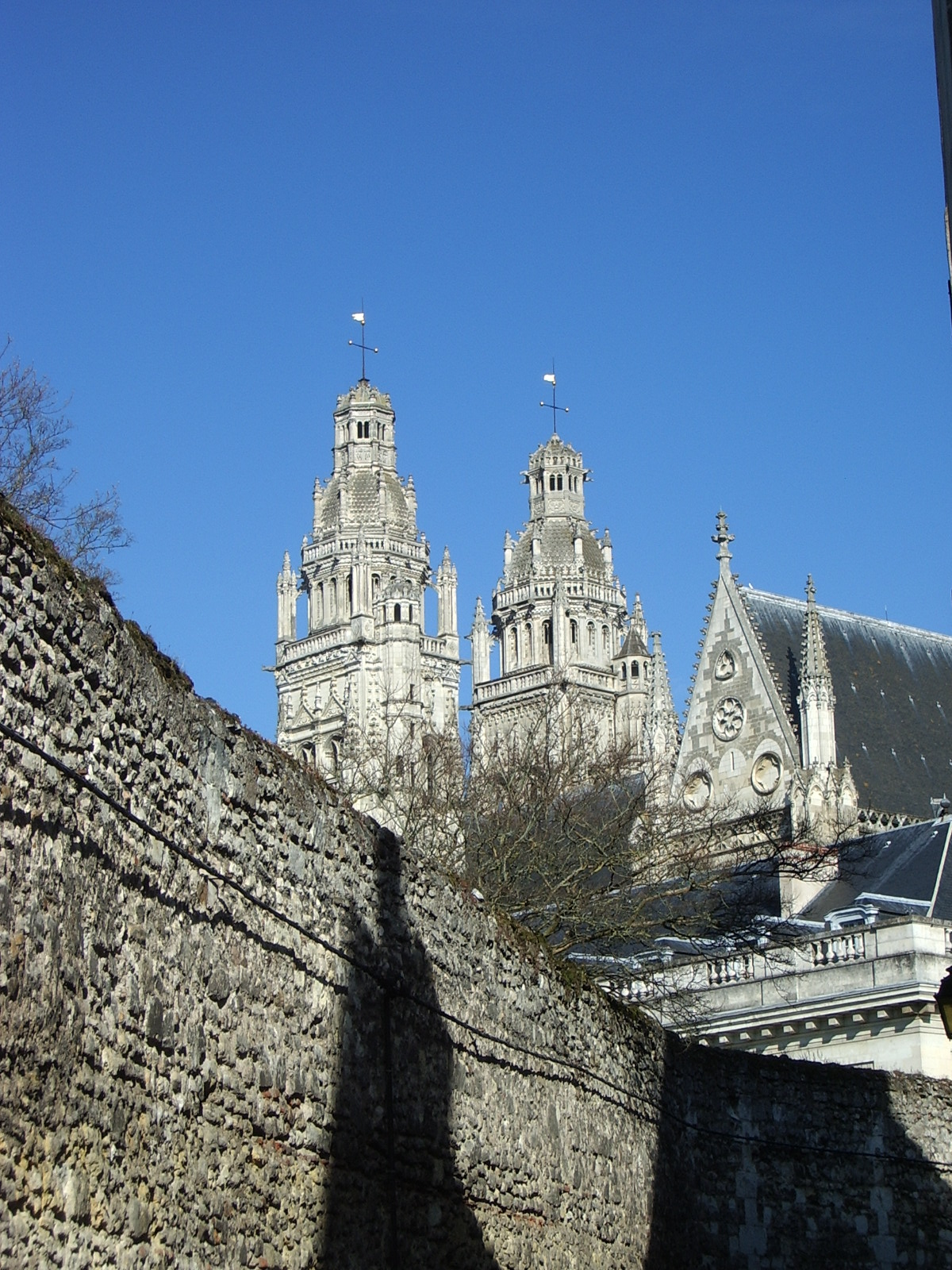
Cathédrale de Saint-Gatien, Tours, seen from rear: photo by Touffi, 1 May 2006
Before coming to Tours I had never seen a town (other than Heidelberg) that allows the landscape to come so much into its own. There is scarcely more than a ribbon of gray along the banks of the Loire as they pass through the town. And the boulevard Grammont passes into the countryside as if through festively built-up, uninhabited meadows. The great stone bridge is suspended shallowly above the river, like a hand stroking it. Everything is low, apart from a few lofty towers.

Pont Wilson over the River Loire at Tours, with Cathédrale de Saint-Gatien in distance: photo by Guil37, 3 April 2007
It is a town à la portée des enfants; it gives me pleasure to reflect the great Catholic children's-book publisher Mame is based in Tours.
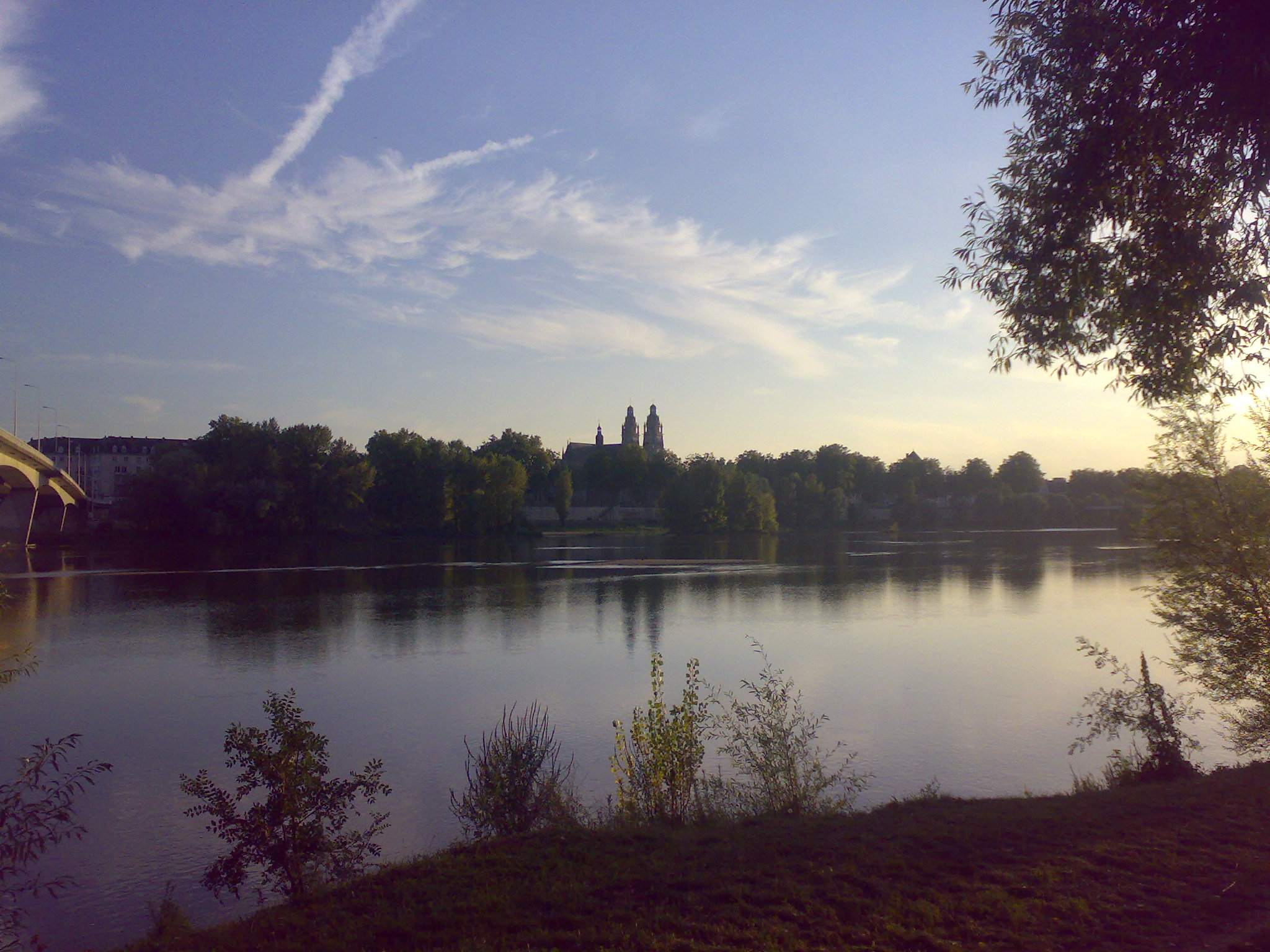
Looking back towards central Tours from the north bank of the River Loire, adjacent to the Pont Mirabeau: photo by Ozeye, 13 September 2007
Walter Benjamin: from Diary of My Journey to the Loire, August 1927, unpublished in the author's lifetime, trans. by Rodney Livingstone in Walter Benjamin: Selected Writings, Volume 2: 1927-1934, 1999




9 comments:
Exquisite photographs..I wasn't previously acquainted with Walter Benjamin, but after reading what you posted of his diary, I had to find some bio about him. A remarkable man, beyond erudite with an exceedingly cultured mind and background. His death..another sacrifice to Hitler's complicit Jewish genocide when all the safety nets were cut:
http://en.wikipedia.org/wiki/Walter_Benjamin
Thank you for this beautiful sequence.
A
Strangely connected to his constant feeling of loneliness, these pictures along with his personal collect of details like the names of the streets, become all the more fascinating... oui, vraiment merci.
Benjamin's diary of the Loire journey seems to me a remarkable document, with its insistent, obsessive "double story-line" -- the painfully candid self-revelation of private romantic melodrama on the one hand, the virtuosic response to the glorious architecture on the other. The travel writer keeps being undermined by the pathos of the unsuccessful lover. And without knowing the identity of L. -- may heavens be blessed for saving some few privacies from the cruel peeping eye of "history" -- we are reduced to the subjective, perhaps narcissistic perspective of the diarist, whose acute consciousness of loneliness is indeed sad and poignant, but whose oddly distant attitude, in phrases like "In Paris I can survive without her, and indeed cannot really make use of her" also discloses the chilliness of the self-analytical intellectual, dooming himself to loneliness. One may write for one's amusement the complementary diary of L. One may imagine the mirror turning into a transparent lens. The past is a hall of mirrors, finally...
Yes, Walter Benjamin’s writing here was meant to be both a travelogue and a diary, a melding of his outer and inner impressions of place and his state of mind. As he wrote about the aspects of cathedrals he observed:
“Incidentally, this rose window is an unsurpassable symbol of the Church's way of thinking: from the outside, all slaty, scaly, almost leprous; from the inside, blossoming, intoxicating and golden.”
… Walter Benjamin: Selected Writings, Volume 2: 1927-1934―
When it comes to observing Walter Benjamin’s mind as we have been privy to it in this travel diary, one might say the same thing about how a man views his life in relation to the beauty and splendor revealed in the spiritual aspects of the art he is viewing.
I don’t believe that words like ‘narcissistic’ and other such judgments can apply to the context as a whole or in part of what Walter Benjamin wrote here. He as a ‘diarist’ had a perfect right to include the phenomenon/self observations of himself into his experiences of place that included at times, other visitors besides, and in contrast to himself.
We have a tendency in our time, to diminish the art, work, novels, poetry of many others in the past and present by bringing in key and buzz words from common psychological usage. Whatever Benjamin’s relationship was with L. only implies that Walter Benjamin, a man of flesh and blood, a scrupulous observer, had brought his awareness..
”from the outside, all slaty, scaly, almost leprous; from the inside, blossoming, intoxicating and golden.”
…and mind to bear on the magnificence of the Loire cathedrals.
Again, thank you for this most interesting presentation of Walter Benjamin.
A
Tom,
A wonderful slide show of photos, coupled with Benjamin's writing of world out there (what he's seeing) and in there (what he's thinking/feeling) -- yes, "sad and poignant" indeed. . . . Having myself seen some of these same places almost thirty years ago, traveling with then wife and then eight year old daughter, seems to make all this even more moving. . . .
7.25
grey whiteness of fog against invisible
top of ridge, motion of shadowed leaves
in foreground, wave sounding in channel
whether or not this it that
is, as a glance shows
a corresponding system, i.e.,
in place of variables
grey white clouds reflected in channel,
shadowed green slope of ridge above it
Thank you for publishing this and assembling such a moving and revelatory collection of photographs to illustrate Benjamin's writing. Impossible to pick out favorite passages from the "double story-line" -- the descriptions of internal thoughts and feelings and external sights and objects are all so profound. It is impossible to forget, however, "total harmony of landscape, architecture and the art of gardening" and the description of the relationship of the church and the rose window. Curtis
Thanks to all.
Steve, I too traveled this route, in the summer of 1964. Hitchhiking, youth hosteling, ah the days of arriving exhausted out of an empty field at the foot of stone magnificence. Suddenly it all made sense -- as Curtis quotes WB, "total harmony of landscape, architecture..."
Artemisia, perhaps "narcissism" was an unfortunate word choice; it was meant to be descriptive, not judgmental. Any relation to pop psychology is regrettable and accidental.
WB was a human, and an odd bird, like most of us, and his honesty in his diary is engaging and at moments disarming.
However his habit of projecting his own psychic contents upon others, and in particular upon women, seems to have been a part of his makeup not detachable from the extreme brilliance, sensitivity and erudition.
I think that can be fairly said, for example, about Walter Benjamin: Ariadne's Red Thread.
(By "projecting," I mean to suggest that as far as we are able to make out, the mysterious absent L. has no "objective" existence; she's a blank; what we may think we know about her, really, is something that turns out to be about Benjamin, an aspect of his intense subjectivity; and I think it's that intensity, in turn, which gives such unusual emotional presence to the architecture.)
Tom,
Ah yes, those WERE the days (something of which THIS brings back, for which all thanks). . . .
Post a Comment